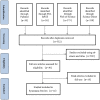Dietary intervention improves metabolic levels in patients with type 2 diabetes through the gut microbiota: a systematic review and meta-analysis
- PMID: 38260058
- PMCID: PMC10800606
- DOI: 10.3389/fnut.2023.1243095
Dietary intervention improves metabolic levels in patients with type 2 diabetes through the gut microbiota: a systematic review and meta-analysis
Erratum in
-
Corrigendum: Dietary intervention improves metabolic levels in patients with type 2 diabetes through the gut microbiota: a systematic review and meta-analysis.Front Nutr. 2024 Apr 29;11:1414687. doi: 10.3389/fnut.2024.1414687. eCollection 2024. Front Nutr. 2024. PMID: 38742024 Free PMC article.
Abstract
Background: Poor dietary structure plays a pivotal role in the development and progression of type 2 diabetes and is closely associated with dysbiosis of the gut microbiota. Thus, the objective of this systematic review was to assess the impact of dietary interventions on improving gut microbiota and metabolic levels in patients with type 2 diabetes.
Methods: We conducted a systematic review and meta-analysis following the PRISMA 2020 guidelines.
Results: Twelve studies met the inclusion criteria. In comparison to baseline measurements, the high-fiber diet produced substantial reductions in FBG (mean difference -1.15 mmol/L; 95% CI, -2.24 to -0.05; I2 = 94%; P = 0.04), HbA1c (mean difference -0.99%; 95% CI, -1.93 to -0.03; I2 = 89%; P = 0.04), and total cholesterol (mean difference -0.95 mmol/L; 95% CI, -1.57 to -0.33; I2 = 77%; P = 0.003); the high-fat and low-carbohydrate diet led to a significant reduction in HbA1c (mean difference -0.98; 95% CI, -1.50 to -0.46; I2 = 0%; P = 0.0002). Within the experimental group (intervention diets), total cholesterol (mean difference -0.69 mmol/L; 95% CI, -1.27 to -0.10; I2 = 52%; P = 0.02) and LDL-C (mean difference -0.45 mmol/L; 95% CI, -0.68 to -0.22; I2 = 0%; P < 0.0001) experienced significant reductions in comparison to the control group (recommended diets for type 2 diabetes). However, no statistically significant differences emerged in the case of FBG, HbA1c, HOMA-IR, and HDL-C between the experimental and control groups. The high dietary fiber diet triggered an augmented presence of short-chain fatty acid-producing bacteria in the intestines of individuals with T2DM. In addition, the high-fat and low-carbohydrate diet resulted in a notable decrease in Bacteroides abundance while simultaneously increasing the relative abundance of Eubacterium. Compared to a specific dietary pattern, personalized diets appear to result in the production of a greater variety of beneficial bacteria in the gut, leading to more effective blood glucose control in T2D patients.
Conclusion: Dietary interventions hold promise for enhancing metabolic profiles in individuals with T2D through modulation of the gut microbiota. Tailored dietary regimens appear to be more effective than standard diets in improving glucose metabolism. However, given the limited and highly heterogeneous nature of the current sample size, further well-designed and controlled intervention studies are warranted in the future.
Keywords: dietary intervention; gut microbiota; short-chain fatty acids; systematic review; type 2 diabetes.
Copyright © 2024 Xu, Zhang, Ren, Zhang, Jing, Wei, Jiang and Xie.
Conflict of interest statement
The authors declare that the research was conducted in the absence of any commercial or financial relationships that could be construed as a potential conflict of interest.
Figures




Similar articles
-
The Role of Dietary Fibre in Modulating Gut Microbiota Dysbiosis in Patients with Type 2 Diabetes: A Systematic Review and Meta-Analysis of Randomised Controlled Trials.Nutrients. 2020 Oct 23;12(11):3239. doi: 10.3390/nu12113239. Nutrients. 2020. PMID: 33113929 Free PMC article.
-
Systematic review assessing the effectiveness of dietary intervention on gut microbiota in adults with type 2 diabetes.Diabetologia. 2018 Aug;61(8):1700-1711. doi: 10.1007/s00125-018-4632-0. Epub 2018 May 12. Diabetologia. 2018. PMID: 29754286 Free PMC article.
-
The Effect of Dietary Fibre on Gut Microbiota, Lipid Profile, and Inflammatory Markers in Patients with Type 2 Diabetes: A Systematic Review and Meta-Analysis of Randomised Controlled Trials.Nutrients. 2021 May 26;13(6):1805. doi: 10.3390/nu13061805. Nutrients. 2021. PMID: 34073366 Free PMC article.
-
Effect of traditional Chinese medicine on gut microbiota in adults with type 2 diabetes: A systematic review and meta-analysis.Phytomedicine. 2021 Jul 15;88:153455. doi: 10.1016/j.phymed.2020.153455. Epub 2020 Dec 30. Phytomedicine. 2021. PMID: 33478831
-
Comparison of low- and high-carbohydrate diets for type 2 diabetes management: a randomized trial.Am J Clin Nutr. 2015 Oct;102(4):780-90. doi: 10.3945/ajcn.115.112581. Epub 2015 Jul 29. Am J Clin Nutr. 2015. PMID: 26224300 Clinical Trial.
Cited by
-
Analysis of the Preventive Effect of Lonicera caerulea Pomace and Its Isolated Components on Colitis in Mice Based on Gut Microbiota and Serum Metabolomics.Antioxidants (Basel). 2024 Nov 30;13(12):1478. doi: 10.3390/antiox13121478. Antioxidants (Basel). 2024. PMID: 39765807 Free PMC article.
-
The Relationship of Certain Diseases and Dietary Inflammatory Index in Older Adults: A Narrative Review.Curr Nutr Rep. 2024 Dec;13(4):768-785. doi: 10.1007/s13668-024-00566-4. Epub 2024 Sep 4. Curr Nutr Rep. 2024. PMID: 39230632 Review.
-
Association between gut microbiota and ultra-processed foods consumption among the patients with type 2 diabetes: a cross-sectional study.Nutr Metab (Lond). 2024 Dec 20;21(1):110. doi: 10.1186/s12986-024-00884-y. Nutr Metab (Lond). 2024. PMID: 39707434 Free PMC article.
-
Nutritional insights into pulmonary fibrosis: a comprehensive review on the impact of vitamins.Front Nutr. 2025 Apr 11;12:1525408. doi: 10.3389/fnut.2025.1525408. eCollection 2025. Front Nutr. 2025. PMID: 40290659 Free PMC article. Review.
-
Effectiveness of Personalized Nutrition on Management Diabetes Mellitus Type 2 and Prediabetes in Adults: A Systematic Review.Diabetes Metab Syndr Obes. 2025 Aug 9;18:2783-2796. doi: 10.2147/DMSO.S528619. eCollection 2025. Diabetes Metab Syndr Obes. 2025. PMID: 40821750 Free PMC article. Review.
References
Publication types
LinkOut - more resources
Full Text Sources
Miscellaneous

